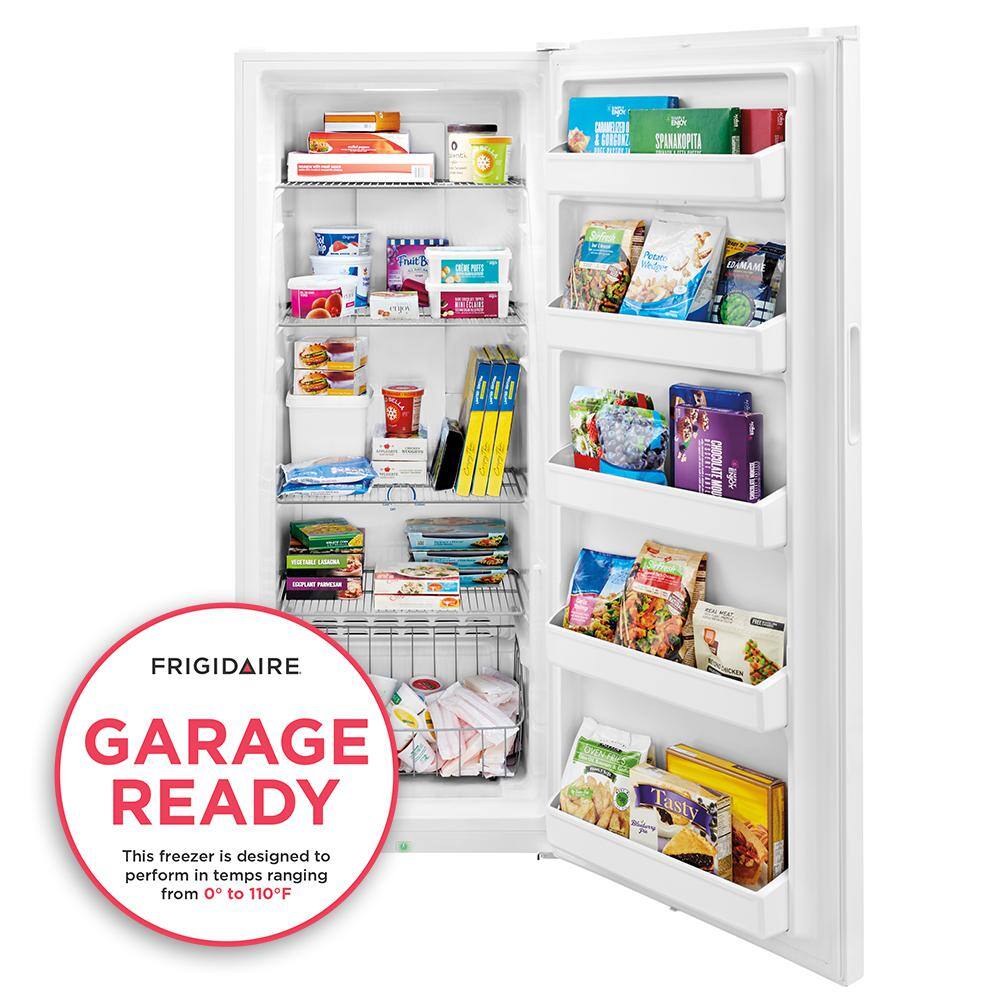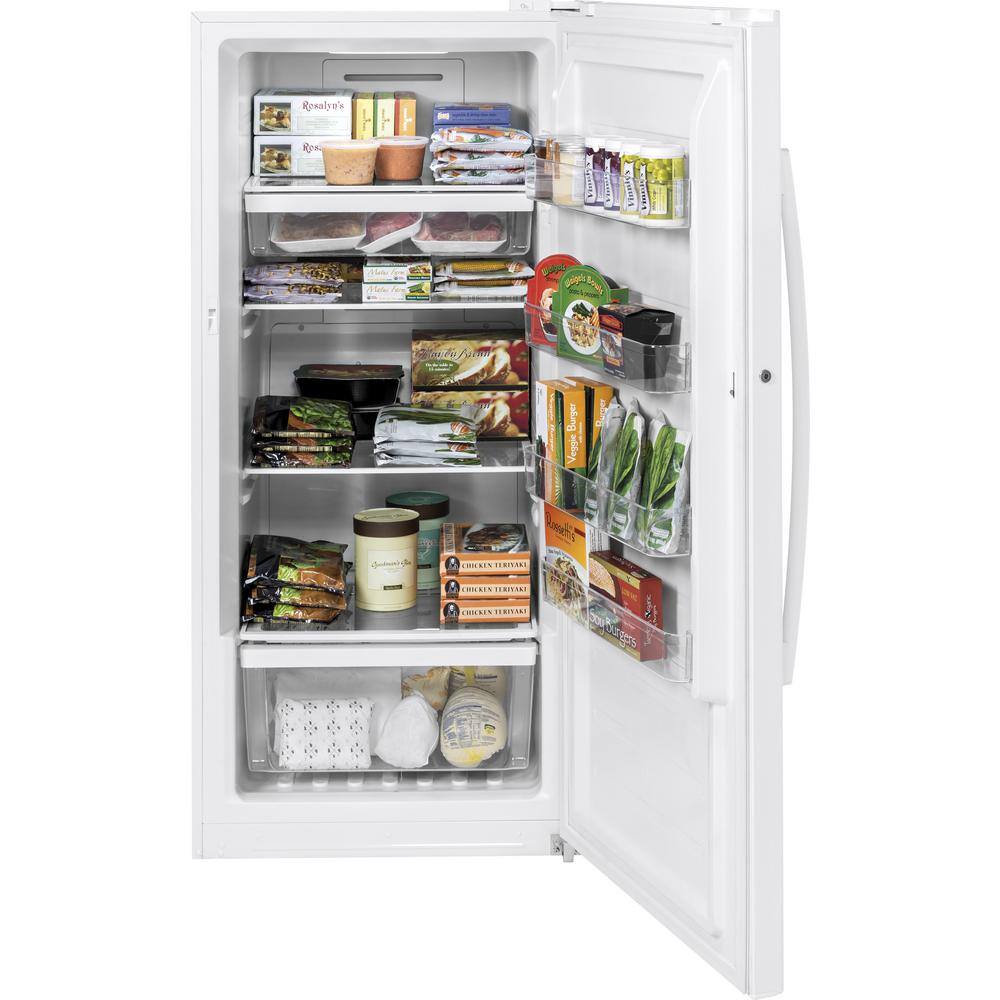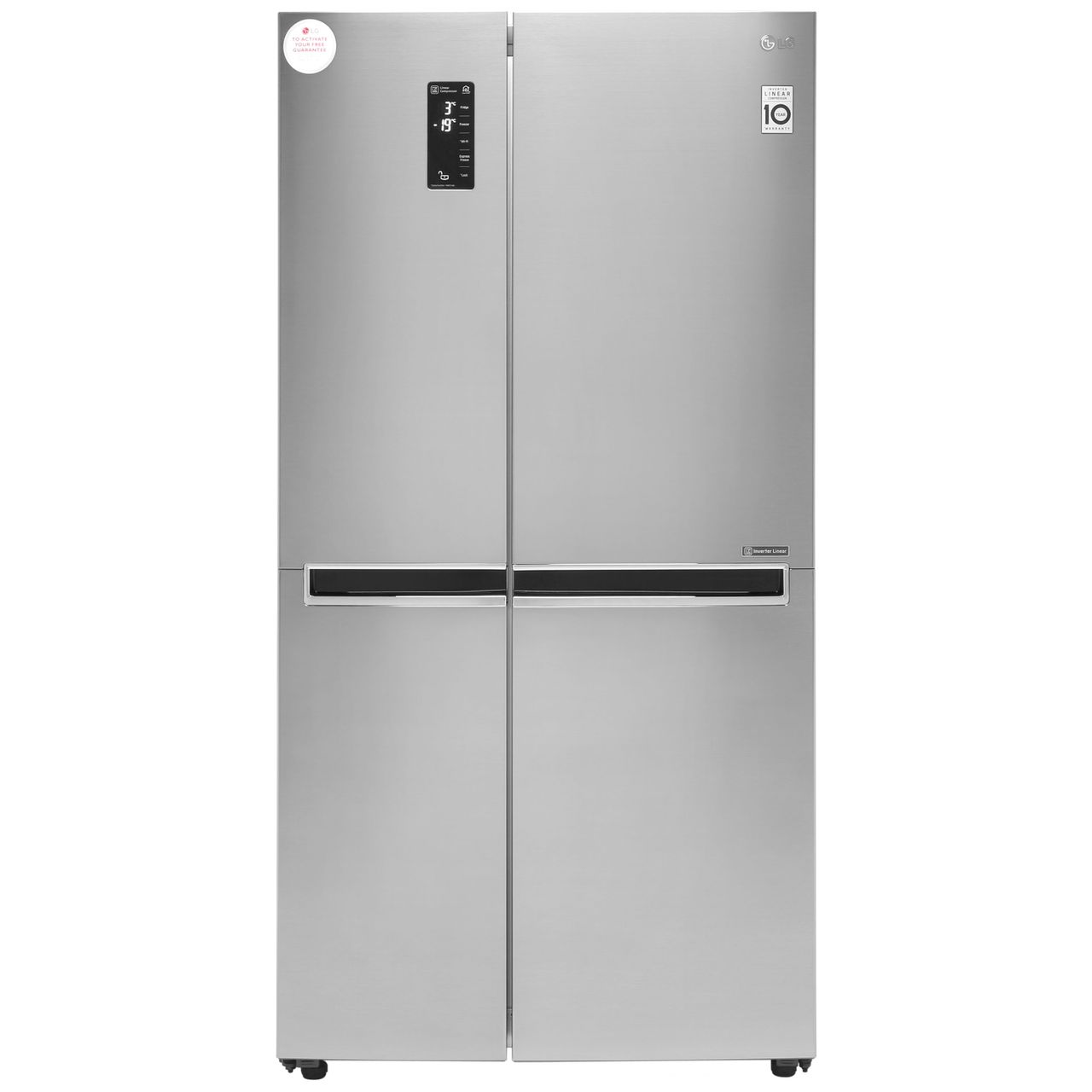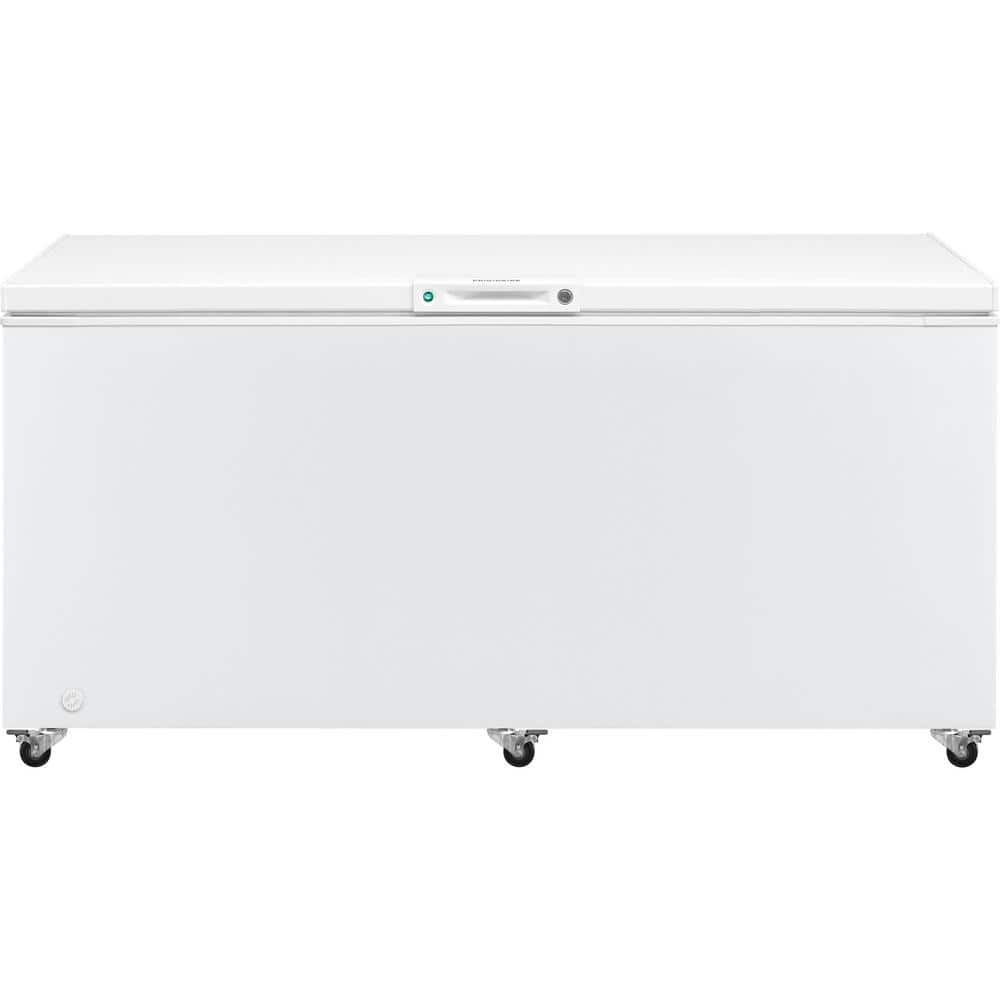Frigidaire 16 cu. ft. Frost Free Upright Freezer with Garage Ready, EvenTemp and Reversible Door in White
Food stays frozen for two days with Power Outage Assurance. Prevent warm spots and unwanted freezing with EvenTemp Cooling. Frost Free Design.
The Frigidaire 16.0 cu. ft. Upright Freezer allows you to conveniently store all of your favorite frozen foods with a variety of ways to organize the interior. Ensure food freshness with a superior tight seal, floor-projected power-on indicator and door ajar alarm. Frigidaire’s EvenTemp Cooling System constantly circulates cold air throughout the freezer with smart sensing technology that adjusts airflow to maintain a uniform temperature, while bright LED lighting ensures you’ll spend less time digging through your freezer for items.
- Flexible interior organization system – Easily organize your family’s frozen favorites with our four adjustable, metallic wire shelves, deep bottom basket, and five spacious door bins that allow you to make the most of every available square inch of your freezer
- Frost-Free Design – Never waste time chipping away ice in your freezer again with our frost-free design that does the work for you
- Power Outage Assurance – Keep food frozen for two days if there is a power outage with our superior tight seal that locks in cold air
- EvenTemp Cooling System – Our EvenTemp cooling system constantly circulates cold air throughout the freezer with smart sensing technology that adjusts air flow to maintain a uniform temperature
- Door Ajar Alarm – Monitor the ideal environment for your frozen foods with our audible temperature alarm that alerts you if the door is left open or the freezer’s temperature rises
- Floor-Projected Power-On Indicator – Know at a glance that your freezer is keeping your favorites safely frozen and fresh with our power-on indicator light
- Internal dial temperature control makes controlling the temperature simple and easy
- Bright LED lighting makes it easy to see what’s inside
- Place this unit in your garage without worry. This unit is designed to perform in temperatures ranging from 0°F to 110°F
Additional information
| Depth (Excluding Handles) | 29.125 |
|---|---|
| Depth (Including Handles) | 29.125 |
| Depth With Door Open 90 Degrees (In) | 55.75 |
| Height to Top of Case (in.) | 67.75 |
| Height to Top of Door Hinge (in.) | 67.75 |
| Minimum Side Air Clearance (In) | 4 |
| Product Depth x Height x Width (in.) | 29.125 x 67.75 x 27.75 |
| Certifications and Listin | UL Listed |
| Warranty Information | One Year Limited |
Sixteen or 16 may refer to:
- 16 (number), the natural number following 15 and preceding 17
- one of the years 16 BC, AD 16, 1916, 2016
A door is a hinged or otherwise movable barrier that allows ingress (entry) into and egress (exit) from an enclosure. The created opening in the wall is a doorway or portal. A door's essential and primary purpose is to provide security by controlling access to the doorway (portal). Conventionally, it is a panel that fits into the doorway of a building, room, or vehicle. Doors are generally made of a material suited to the door's task. They are commonly attached by hinges, but can move by other means, such as slides or counterbalancing.
The door may be able to move in various ways (at angles away from the doorway/portal, by sliding on a plane parallel to the frame, by folding in angles on a parallel plane, or by spinning along an axis at the center of the frame) to allow or prevent ingress or egress. In most cases, a door's interior matches its exterior side. But in other cases (e.g., a vehicle door) the two sides are radically different.
Many doors incorporate locking mechanisms to ensure that only some people can open them (such as with a key). Doors may have devices such as knockers or doorbells by which people outside announce their presence. (In some countries, such as Brazil, it is customary to clap from the sidewalk to announce one's presence.) Apart from providing access into and out of a space, doors may have the secondary functions of ensuring privacy by preventing unwanted attention from outsiders, of separating areas with different functions, of allowing light to pass into and out of a space, of controlling ventilation or air drafts so that interiors may be more effectively heated or cooled, of dampening noise, and of blocking the spread of fire.
Doors can have aesthetic, symbolic, ritualistic purposes. Receiving the key to a door can signify a change in status from outsider to insider. Doors and doorways frequently appear in literature and the arts with metaphorical or allegorical import as a portent of change.
Frigidaire Appliance Company is the American consumer and commercial home appliances brand subsidiary of multinational company Electrolux, a Swedish multinational home appliance manufacturer, headquartered in Stockholm.
Frigidaire was founded as the Guardian Frigerator Company in Fort Wayne, Indiana, and developed the first self-contained refrigerator, invented by Nathaniel B. Wales and Alfred Mellowes in 1916. In 1918, William C. Durant, a founder of General Motors, personally invested in the company and in 1919, it adopted the name Frigidaire.
The brand was so well known in the refrigeration field in the early-to-mid-1900s, that many Americans called any refrigerator a Frigidaire regardless of brand. In France, Canada, and some other French-speaking countries or areas, the word Frigidaire is often in use as a synonym today, and in transcribed form in Serbocroatian also ("frižider", "фрижидер"). Although the alliterative names Frigidaire or its antecedent Frigerator suggest an origin of the widely used English word fridge, it is simply a contraction of refrigerator, a word in use since 1611.
From 1919 to 1979, the company was owned by General Motors. During that period, it was first a subsidiary of Delco-Light and was later an independent division based in Dayton, Ohio. The division also manufactured air conditioning compressors for GM cars. While the company was owned by General Motors, its logo featured the phrase "Product of General Motors", and later renamed to "Home Environment Division of General Motors".
Frigidaire was sold to the White Consolidated Industries in 1979, which in 1986 was purchased by Electrolux, its current parent.
The company claims firsts including:
- Electric self-contained refrigerator (September, 1918 in Detroit)
- Home food freezer
- Room air conditioner
- 30" electric range
- Coordinated colors for home appliances
Frost is a thin layer of ice on a solid surface, which forms from water vapor that deposits onto a freezing surface. Frost forms when the air contains more water vapor than it can normally hold at a specific temperature. The process is similar to the formation of dew, except it occurs below the freezing point of water typically without crossing through a liquid state.
Air always contains a certain amount of water vapor, depending on temperature. Warmer air can hold more than colder air. When the atmosphere contains more water than it can hold at a specific temperature, its relative humidity rises above 100% becoming supersaturated, and the excess water vapor is forced to deposit onto any nearby surface, forming seed crystals. The temperature at which frost will form is called the dew point, and depends on the humidity of the air. When the temperature of the air drops below its dew point, excess water vapor is forced out of solution, resulting in a phase change directly from water vapor (a gas) to ice (a solid). As more water molecules are added to the seeds, crystal growth occurs, forming ice crystals. Crystals may vary in size and shape, from an even layer of numerous microscopic-seeds to fewer but much larger crystals, ranging from long dendritic crystals (tree-like) growing across a surface, acicular crystals (needle-like) growing outward from the surface, snowflake-shaped crystals, or even large, knifelike blades of ice covering an object, which depends on many factors such as temperature, air pressure, air motion and turbulence, surface roughness and wettability, and the level of supersaturation. For example, water vapor adsorbs to glass very well, so automobile windows will often frost before the paint, and large hoar-frost crystals can grow very rapidly when the air is very cold, calm, and heavily saturated, such as during an ice fog.
Frost may occur when warm, moist air comes into contact with a cold surface, cooling it below its dew point, such as warm breath on a freezing window. In the atmosphere, it more often occurs when both the air and the surface are below freezing, when the air experiences a drop in temperature bringing it below its dew point, for example, when the temperature falls after the Sun sets. In temperate climates, it most commonly appears on surfaces near the ground as fragile white crystals; in cold climates, it occurs in a greater variety of forms. The propagation of crystal formation occurs by the process of nucleation, in specific, water nucleation, which is the same phenomenon responsible for the formation of clouds, fog, snow, rain and other meteorological phenomena.
The ice crystals of frost form as the result of fractal process development. The depth of frost crystals varies depending on the amount of time they have been accumulating, and the concentration of the water vapor (humidity). Frost crystals may be invisible (black), clear (translucent), or, if a mass of frost crystals scatters light in all directions, the coating of frost appears white.
Types of frost include crystalline frost (hoar frost or radiation frost) from deposition of water vapor from air of low humidity, white frost in humid conditions, window frost on glass surfaces, advection frost from cold wind over cold surfaces, black frost without visible ice at low temperatures and very low humidity, and rime under supercooled wet conditions.
Plants that have evolved in warmer climates suffer damage when the temperature falls low enough to freeze the water in the cells that make up the plant tissue. The tissue damage resulting from this process is known as "frost damage". Farmers in those regions where frost damage has been known to affect their crops often invest in substantial means to protect their crops from such damage.
A garage is a covered structure built for the purpose of parking, storing, protecting, maintaining, and/or repairing vehicles. Specific applications include:
- Garage (residential), a building or part of a building for storing one or more vehicles
- Automobile repair shop, also called a garage, where vehicles are serviced and repaired
- Bus garage, a building or complex used for storage of buses when not in use
- Filling station, an automotive service station where vehicles take on fuel or recharge
- Multistorey car park, or parking garage, a building serving as a public parking facility
Other meanings of garage may include:
White is the lightest color and is achromatic (having no hue). It is the color of objects such as snow, chalk, and milk, and is the opposite of black. White objects fully reflect and scatter all the visible wavelengths of light. White on television and computer screens is created by a mixture of red, blue, and green light. The color white can be given with white pigments, especially titanium dioxide.
In ancient Egypt and ancient Rome, priestesses wore white as a symbol of purity, and Romans wore white togas as symbols of citizenship. In the Middle Ages and Renaissance a white unicorn symbolized chastity, and a white lamb sacrifice and purity. It was the royal color of the kings of France, and of the monarchist movement that opposed the Bolsheviks during the Russian Civil War (1917–1922). Greek temples and Roman temples were faced with white marble, and beginning in the 18th century, with the advent of neoclassical architecture, white became the most common color of new churches, capitols and other government buildings, especially in the United States. It was also widely used in 20th century modern architecture as a symbol of modernity and simplicity.
According to surveys in Europe and the United States, white is the color most often associated with perfection, the good, honesty, cleanliness, the beginning, the new, neutrality, and exactitude. White is an important color for almost all world religions. The pope, the head of the Roman Catholic Church, has worn white since 1566, as a symbol of purity and sacrifice. In Islam, and in the Shinto religion of Japan, it is worn by pilgrims. In Western cultures and in Japan, white is the most common color for wedding dresses, symbolizing purity and virginity. In many Asian cultures, white is also the color of mourning.
With or WITH may refer to:
- With, a preposition in English
- Carl Johannes With (1877–1923), Danish doctor and arachnologist
- With (character), a character in D. N. Angel
- With (novel), a novel by Donald Harrington
- With (album), a 2014 album by TVXQ
- With (EP), a 2021 EP by Nam Woo-hyun






by Greg
love the wire shelves very sturdy .Works great just wish it was a bit deeper.
by Judy
Perfect size for our needs. Like that the freezer is designed for the garage since that is where we have.
by Arlen
Too early to tell. Check back in a year.
by Robert
Surpasses my expectations, Beautiful efficient frost free Freezer, love the small green light at the bottom of the freezer on the outside of the door , can see it from in the dark.
by Jules
Bought this for my daughter and son in law. It is a great size for their growing family. It fits nicely in the garage and were very happy with the garage ready concept. Nice shelving and great outside surface for cleaning.